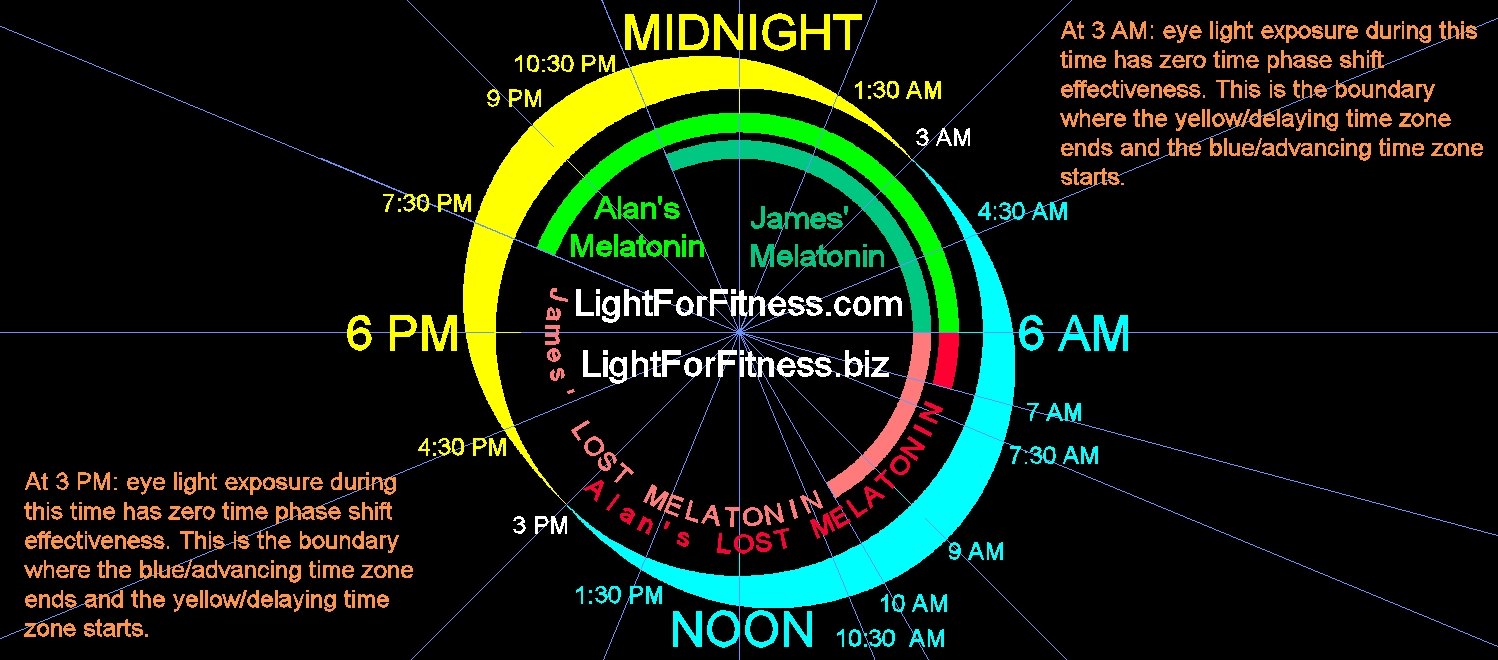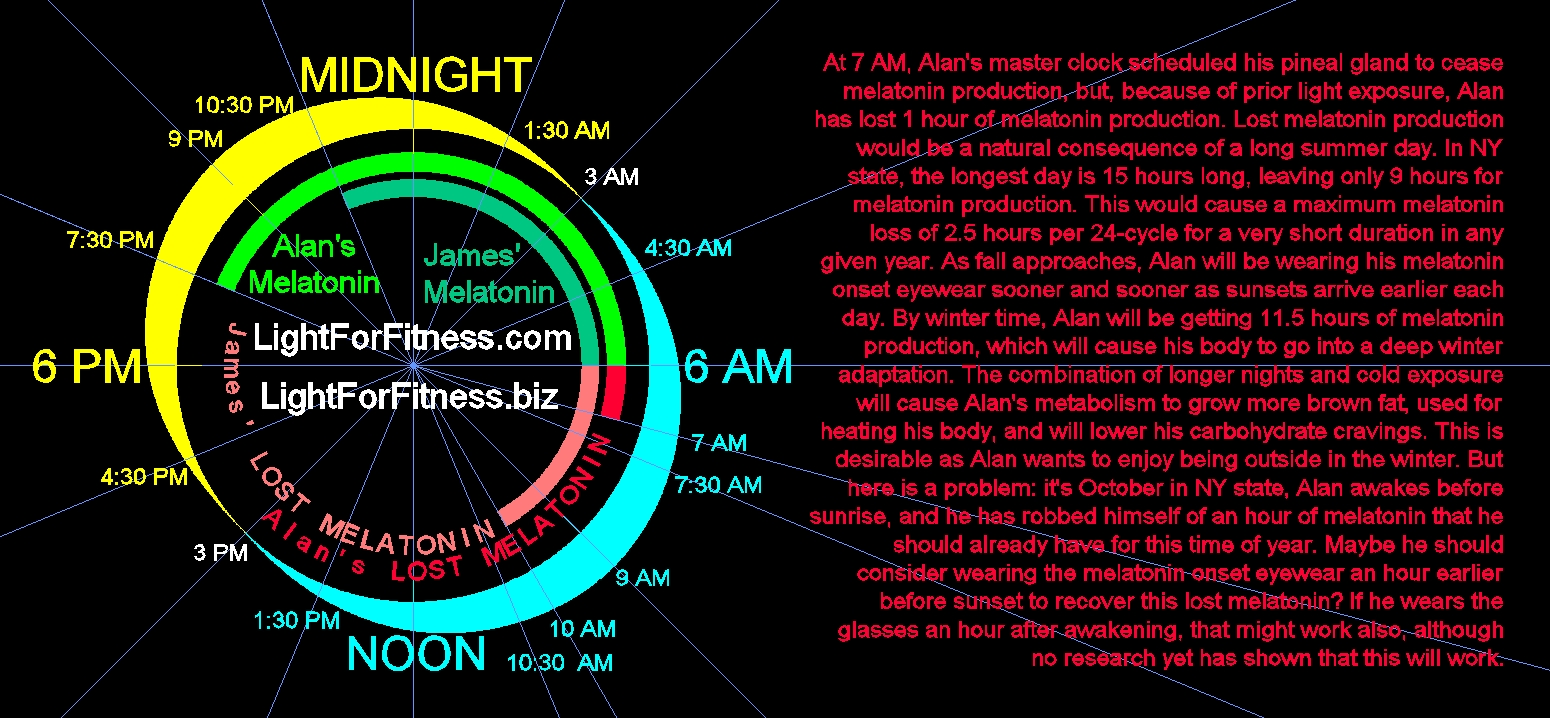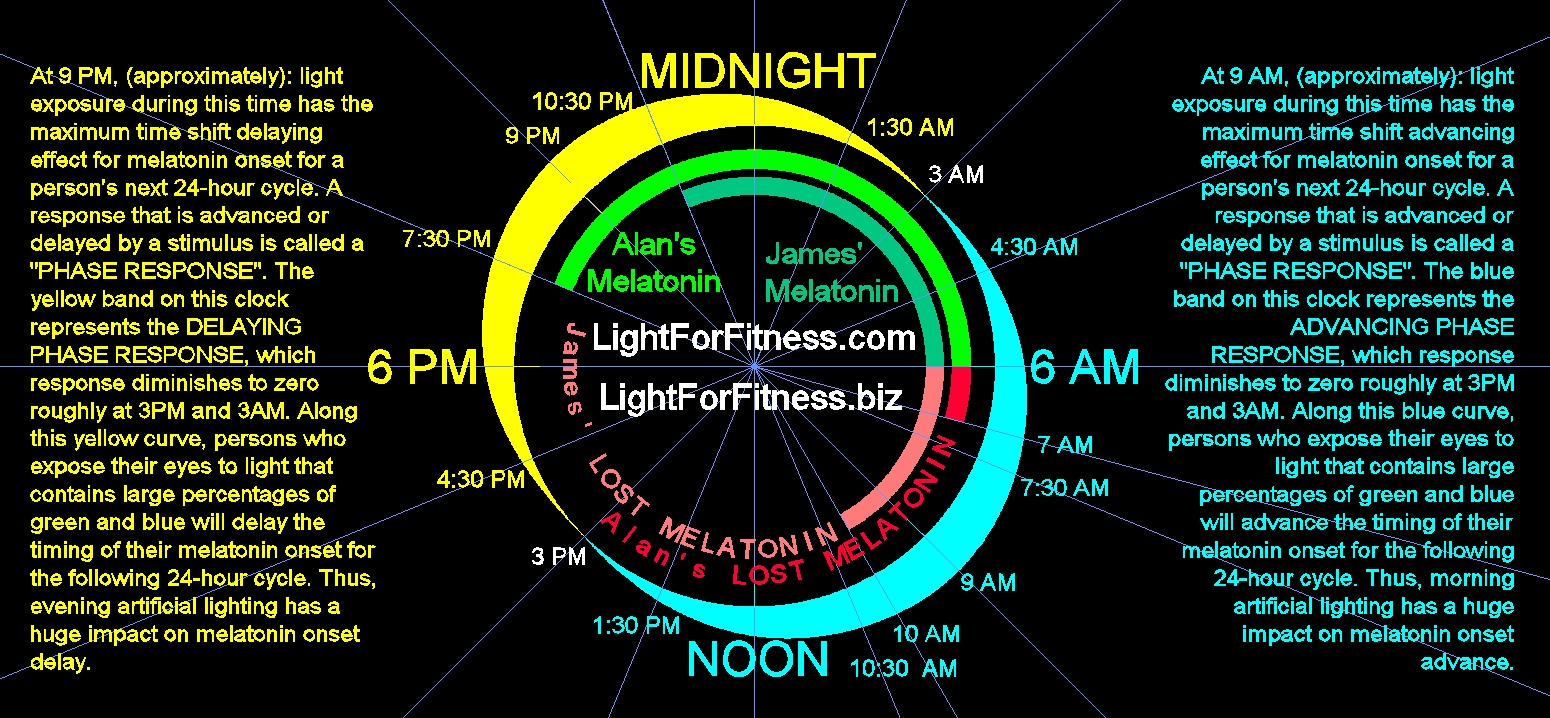MAIN MENU scroll down to read advancing
- ABOUT my transformation
- VIDEO TESTIMONIALS Light-Hygiene
- NEWS and EVENTS about Light For Fitness
- OUR EFFORTS toward Research
- BLOG Posts and Comments
- SCIENTIFIC PAPERS (Doubt? Read!)
- EXPLANATIONS OF TECHNICAL TERMS
- how to use – MELATONIN ONSET EYEWEAR – simple plan
- WHY?
- Why use our melatonin onset eyewear?
- Can I just turn off the BLUE PIXELS and skip wearing the orange glasses? NOPE!
- LINKS
- BUY! ENTER STORE FRONT DOOR LightForFitness.biz
how to use – MELATONIN ONSET EYEWEAR – simple plan scroll down to read advancing
ADVANCING
The next point of interest is 3 AM. The next picture will include commentary on both 3 AM and 3 PM. Any eye light exposure our men have experienced in this graph prior to 3 AM (and after 3 PM) helped to delay their melatonin onsets, but eye light exposure after this time will begin to advance their melatonin onsets for the next 24-hour cycle.
(CLICK ON ANY GRAPHIC TO ENLARGE IT TO FILL THE SCREEN).

Again, the above picture underscores the realties that there are times that eye light exposure encourages melatonin onset to occur earlier, and other times later, and still other times that eye light exposure has no effect on when melatonin onset will occur for the next 24-hour cycle. At approximately 3 AM and 3 PM, the effects from eye light exposure drop to zero and flip from delaying to advancing (after 3 AM), and flip from advancing to delaying (after 3 PM) for the timing of onset of melatonin for the next 24-hour cycle. This is the opposite of the approximate times of 9 AM and 9 PM when light has the maximum effect of either advancing ( at 9 AM) or delaying (at 9 PM) melatonin onset for the next 24-hour cycle.
Next, we move to 6 AM. Things will get very interesting now.
(CLICK ON ANY GRAPHIC TO ENLARGE IT TO FILL THE SCREEN).

This is a key concept that has great importance for those of us who don’t live on the equator, that our master clock in the brain assumes we live on the equator where there is 12 hours of day and 12 hours of night, every day of the year. If we experienced 12 hours of night and 12 hours of day every day of the year, we would enjoy the maximum amount of melatonin our pineal glands could produce continually, 11.5 hours for every 24-hour cycle. However, we would never experience a body that changes metabolically by transitioning between summer and winter adaptions on a yearly basis. We will address this idea of winter and summer adaptions in further detail later when we speak on tailoring a plan.
And just to reiterate, both men live identical light-hygiene lives except one wears melatonin onset eyewear hours prior to going to sleep.
Next, we move on to 7 AM, during October in NY state.
(CLICK ON ANY GRAPHIC TO ENLARGE IT TO FILL THE SCREEN).

Alan has lost melatonin production (note the red tail) because the time he started to wear his melatonin onset eyewear started at sunset (late September in NY state), and he awakes before his pineal gland is exhausted. Because Alan uses melatonin onset eyewear, he could have chosen to preserve his full melatonin production by simply deciding to wear them an hour BEFORE sunset.
He has four choices when he chooses to wear his melatonin onset eyewear. He can keep it simple and start wearing the glasses once the sun sets. That’s the “Simple Plan”. But, he also could have chosen to use the “Home-Town Plan”, the “Lower Latitude Plan” or the “Equator Plan”.
Although Alan is in the earlier, experimental phase and is happy with the simple plan, maybe later he will tailor a plan for himself because he wonders if that hour of melatonin production would be worth recovering during October.
To conclude the advancing topic in the table of contents, we will look at 9 AM, the peak time when light advances melatonin onset. This is the time of day when MORNING SIMULATORS have their greatest impact, as does any other form of bright lighting (green and blue rich), to advance melatonin onset and defeat the symptoms of SAD (seasonal affective disorder). BUT, despite the fact that Alan and James enjoyed the exact same benefit of light during this peak time, James’ poor light-hygiene practices at night wiped out his onset advancement gains from this morning time, whereas Alan’s use of evening-time melatonin onset eyewear preserved the advancement gains he received at 9 AM, and thus allowed his melatonin onset to occur earlier than James’.

Both men have varying degrees of LOST melatonin for this given day as both could have had a longer period of melatonin if their onsets would have occurred earlier or their exposure to light would have been delayed to a later time(s) that morning. How bad are these losses? We will discuss this more under the tailoring item of our table of contents. Click on Understanding Tailoring below to continue.
how to use – MELATONIN ONSET EYEWEAR – simple plan scroll up to read advancing
MAIN MENU scroll up to read advancing
- ABOUT my transformation
- VIDEO TESTIMONIALS Light-Hygiene
- NEWS and EVENTS about Light For Fitness
- OUR EFFORTS toward Research
- BLOG Posts and Comments
- SCIENTIFIC PAPERS (Doubt? Read!)
- EXPLANATIONS OF TECHNICAL TERMS
- how to use – MELATONIN ONSET EYEWEAR – simple plan
- WHY?
- Why use our melatonin onset eyewear?
- Can I just turn off the BLUE PIXELS and skip wearing the orange glasses? NOPE!
- LINKS
- BUY! ENTER STORE FRONT DOOR LightForFitness.biz